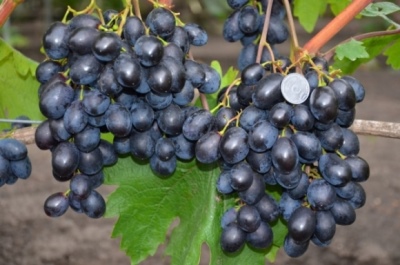
- Authors: Burdak Alexander Vasilievich
- Appointment: dining room
- Berry color: dark blue
- Taste: harmonious
- With bones: No
- Ripening period: very early
- Ripening period, days: 95-100
- Frost resistance, ° C: -23
- Bunch weight, g: 500-1000
- Flower type: bisexual
The dark grape variety is very popular with modern growers. Among the table varieties, Black Crystal stands out - a bush that is unpretentious in care, but at the same time it pleases with ripe fruits and their taste.
Breeding history
It is necessary to thank the breeder Alexander Vasilyevich Burdak for breeding the described variety.
Geography of distribution
Since the variety is not particularly winter-hardy, it is grown mainly in the south and the Urals, and can be found in the Moscow region.
Description
Bisexual flowers form on the bushes. The plant itself belongs to the category of vigorous, accordingly, an important part of care is pruning.
Up to two inflorescences are formed on the shoot, the same number of clusters.
The foliage has a dark green tint, no pubescence. Greens are three-lobed, without dissection.
Ripening period
After budding, it takes 95 to 100 days before the fruit can be harvested. Black Crystal belongs to varieties with a very early ripening period.
Bunches
The bunch grows long, its density can be estimated as loose. The weight can vary from 500 grams to 1 kilogram.
Berries
The dark blue fruits are completely boneless. The inside is dense, crispy flesh.
The mass of one grape is from 8 to 12 grams.
Taste
Tasters rate the taste of Black Crystal as harmonious.
Yield
This is a fruitful variety.


Growing features
After the entire crop has been harvested from the bush, and the pruning has been carried out, it is necessary to treat the grapes with a solution of copper or iron.
When new shoots begin to grow, watch out for pests that can hinder vigorous growth.
Do not allow weeds to grow next to grape seedlings, as they suck out not only moisture, but also nutrients from the soil.
Landing
When planting Black Crystal, they dig a small hole about 16 centimeters in diameter and 15 cm deep. In soils with a high clay content, the sides of the hole can harden, which can inhibit future root growth. In this situation, break up these areas with a shovel or similar tool.
Immediately before planting, the roots are pruned. Cut off the top growth to two or three buds.
They put the plant in a hole and cover it with soil. Place the trellis next to the vine to ensure proper stability. Water the vine with two or three buckets of water immediately after planting.

Pollination
The described variety forms bisexual flowers, which means there is no need for additional pollination.
Pruning
Since the variety is vigorous, it needs to be pruned every year, and sometimes more than once. This should be done during a period when there is no sap flow along the vine.

Watering
Be sure to water the young vines well, but the soil cannot be waterlogged. The amount and frequency of irrigation varies depending on the region and environmental conditions. It is preferable to use drip irrigation to keep moisture out of the leaves.


Top dressing
Nitrogen can be given in the first year after planting. It will give the shoots the necessary growth. Then its amount is reduced, otherwise foliage will form, and not fruits.
When crops are ripe, complex fertilizers with slow release of nutrients are ideal.
Frost resistance and the need for shelter
Frost resistance of Black Crystal is at the level of -23 degrees. If the variety is grown in the southern region, then it does not need shelter. In areas where winters are harsh, spring frosts are observed, it is recommended to clear the vine of leaves before winter, remove it from the trellis and lay it in a small trench in the ground. From above, the grapes are sprinkled with a layer of soil, the thickness of which should be 25-30 cm.

Diseases and pests
Black Crystal is processed several times per season. The first spraying should be done in early spring, before the leaves appear.
Use insecticides to prevent insect infestation. Fungicides, including sulfur-based, help the gardener cope with various diseases.

If a grape is exposed to any disease or insect, this always affects its appearance.
Storage
It is not necessary to immediately harvest the crop, it is perfectly stored on the bushes until the very frost.











































































